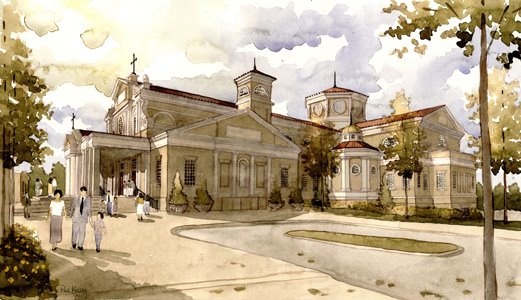To save the Catholic Church, redesign it

Modernizing the Catholic Church usually doesn't refer to architecture. But it should.
In the wake of abuse scandals and resignation of Pope Benedict XVI, it seems the perfect moment to explore a new language of church design. The new Pope Francis, charismatic and somewhat socially progressive, could inspire today's look. Yet Catholics and their commentators this year, as ever, are conservative to a fault when it comes to the physical trappings of their faith.
Bring us traditional architecture, they say, for the good of mankind.
Highlighting the mood, last week the news was about the imminent selection of an architect to help redesign Crystal Cathedral, which a Catholic diocese in Southern California bought for $57 million. Designed by Philip Johnson, with an arboretum by Richard Neutra and a welcome center by Richard Meier, the glass-cloaked complex has an auditorium-style nave.
Auditorium? No good for Catholic worship, say conservative critics.
Form follows faith?
It's not just the blasphemy of "people-oriented worship spaces," as blogger Thom Nickels has opined for The Huffington Post. It's also the symbolic power of art in the church, too.
In June, a high-level Vatican official criticized modernist church architecture. The sentiment was echoed all over.
It was Cardinal Gianfranco Ravasi, head of the Vatican’s cultural council, who sees "a lack of integration between the architect and the faith community." The same month, the Vatican opened an art exhibit at the Venice Biennale, on display through November, trying to bring art and religion closer together.

The three-room installation suggests a church in synch with contemporary arts. While the sepia photographs by Josef Koudelka and monotone paintings by American artist Lawrence Carroll -- and interactive videos by Milan's Studio Azzurro -- all focus on the theme of (biblical) creation, they are stark, intense and very modern.
We like old things
Inside the church, however, Catholics won't bear it. They call for statuary that is representational, old-looking and familiar. And they want "sacred places, not meeting spaces," as Michael S. Rose wrote in his book, Ugly as Sin. Pews for people? Perish that un-Catholic thought.
Many conservative Catholics blame the reforms of the early 1960s Second Vatican Council, which addressed relations between the Roman Catholic Church and modernity. These critics think Vatican II opened the door for U.S. bishops to experiment with church styles and layouts. Rose wrote that the "new-style churches aren't merely "ugly, they actually distort the faith and lead Catholics away from Catholicism."
What power does historicism have over the faithful? Relics are worshipped, period. Even the ones made yesterday in a factory and distressed by hand to look all old and authentic-looking. Conduct a focus group -- I dare you -- and you'll hear the most fervently religious asking for more historic-looking churches.
Many of the newest U.S. church designs reflect this predilection.
America's new traditionalists
Last week the National Catholic Register quoted Denis McNamara, an architectural historian in Chicago, spotting the trend that U.S. Catholic church architecture "is definitely, without question, becoming more traditional” over the last few years, adding that, "With the exception of a few recent cathedrals on the West Coast, the era of hiring a famous modernist star architect is over."
Emblematic of the “new traditional Catholic architecture” are Houston's Our Lady of Walsingham, Nashville's Motherhouse Chapel, and new churches named for saints in Westerville, Ohio; Leawood, Kan.; and Leesburg, Va. These churches look old and, in some cases, expensive. The designs range from banal to brilliant, with some clearly undertaken by accomplished classical architects.
Yet, the walls, built using unseen modern technology, only pretend to be old. Do the churchgoers share this duality? They are modern folks, cloaked on Sunday morning in an idea of antiquity.
In spite of the trend, the success of modern churches can't be denied. The best example may be Richard Meier's Church of 2000 in Rome, a remarkable, brilliantly sunlit spiritual experience that exalts man and God. Go inside, and you will believe.
America's best cathedral
Other works suggest the earthly powers of gravity, firmament, and the inspiration of the heavens and the strength that is enduring faith. The Latin-rite Cathedral of Our Lady of the Angels in Los Angeles, designed by Rafael Moneo, is among the most convincing. It has a lively, growing congregation, and people who worship there absolutely love the place.
For tradition-minded Catholic visitors, it's hard to understand the attraction.
But as the Los Angeles congregants show, the church is changing. The times are changing. And the Catholics -- and their worship halls -- should move along with them.
This post was originally published on Smartplanet.com